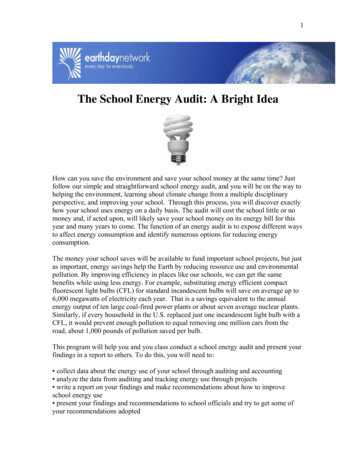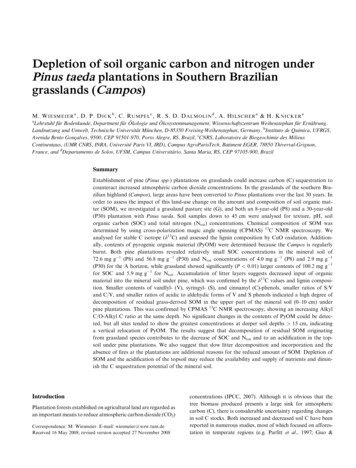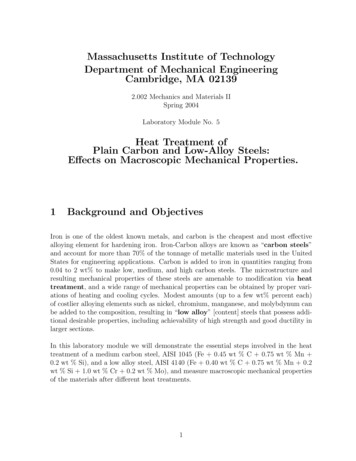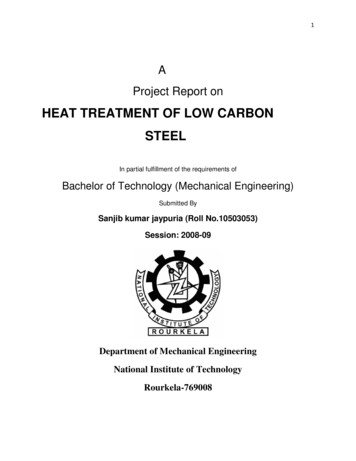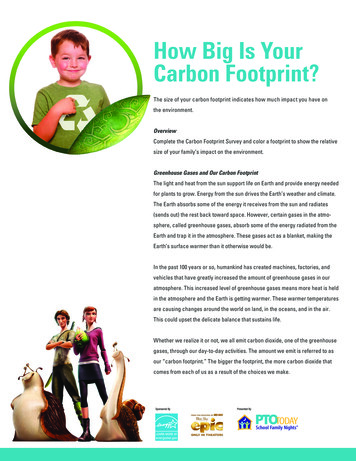
Transcription
How Big Is YourCarbon Footprint?The size of your carbon footprint indicates how much impact you have onthe environment.OverviewComplete the Carbon Footprint Survey and color a footprint to show the relativesize of your family’s impact on the environment.Greenhouse Gases and Our Carbon FootprintThe light and heat from the sun support life on Earth and provide energy neededfor plants to grow. Energy from the sun drives the Earth’s weather and climate.The Earth absorbs some of the energy it receives from the sun and radiates(sends out) the rest back toward space. However, certain gases in the atmosphere, called greenhouse gases, absorb some of the energy radiated from theEarth and trap it in the atmosphere. These gases act as a blanket, making theEarth’s surface warmer than it otherwise would be.In the past 100 years or so, humankind has created machines, factories, andvehicles that have greatly increased the amount of greenhouse gases in ouratmosphere. This increased level of greenhouse gases means more heat is heldin the atmosphere and the Earth is getting warmer. These warmer temperaturesare causing changes around the world on land, in the oceans, and in the air.This could upset the delicate balance that sustains life.Whether we realize it or not, we all emit carbon dioxide, one of the greenhousegases, through our day-to-day activities. The amount we emit is referred to asour “carbon footprint.” The bigger the footprint, the more carbon dioxide thatcomes from each of us as a result of the choices we make.Sponsored ByPresented By
Climate change caused by excess greenhouse gases and a big carbon footprint can cause: Heat waves that damage crops, stress livestock, and make life difficult for people. More air pollution, which is linked to allergies, asthma, and other health problems. Severe storms and flooding due to higher sea levels. Loss of habitat as the climate changes, particularly in Arctic regions.Families can help reduce their carbon footprint by focusing on four major areas that generate excess carbondioxide: housing and household energy use, transportation, personal habits, and recycling. In this game,you’ll have the chance to estimate the relative size of your family’s carbon footprint as well as learn easyways you can help reduce it.Materials: Carbon Footprint Survey sheet, one per family team Carbon Footprint drawing Crayons, markers, or colored pencils in the suggested colorsThe Carbon Footprint Survey will ask a series of questions that will direct the participant to color linesaround the footprint drawing. The more greenhouse gases you produce, based on your answers, the biggerthe carbon footprint grows. Different color crayons will represent the four categories of behavior surveyed: Housing and Home Energy: RED Transportation: BLUE Personal Habits: GREEN Recycling Habits: BROWNSponsored ByPresented By
Carbon Footprint Survey:How Big Is Your Family’s Carbon Footprint?Some of our lifestyle choices and day-to-day activities emit excess carbon dioxide and other greenhouse gasesinto the atmosphere. The amount of greenhouse gases we produce is referred to as our “carbon footprint.” Toomuch carbon dioxide and other greenhouse gases in our atmosphere can lead to unnatural climate change, whichcan have a harmful effect on our planet. Take this survey to get a sense of the size of your family’s carbon footprint.Housing and Home EnergyPersonal Habits1. If you live in a single-family home, color 4 rings RED;9. If you are a vegetarian, color 1 ring GREEN; if youif you live in an apartment or other type of home,color 2 rings RED.2. If you don’t use energy-efficient light bulbs such asCFLs (compact fluorescent), color 1 more ring RED.3. If your home doesn’t have a programmablethermostat, color 1 more ring RED.are not a vegetarian, color 2 rings GREEN.10. If you never eat organic food, color 1 morering GREEN.11. If you take baths, run the faucet while brushingyour teeth or washing dishes, or water yourlawn several times a week, color 1 ring GREEN.4. If you are not familiar with the Energy Star appliance rating system, color 1 more ring RED.Recycling and Waste12. If you usually recycle your household trash,Transportationcolor 1 ring BROWN; if you never recycle, color5. For every small car in your family, color 1 ring BLUE.2 rings BROWN.6. For every medium or large car in your family, color2 rings BLUE.7. If you don’t regularly change the air filter on yourcar and check the tire pressure, color 1 more13. If you never compost your yard and kitchen waste,color 1 more ring BROWN.Now read on to learn what you can do to reduce thesize of your carbon footprint.ring BLUE.8. For every airplane trip you’ve taken in the past year,color 1 more ring BLUE.Sponsored ByPresented By
What can you do to reduce the sizeof your carbon footprint?1. Single-family homes generally consume more energyper resident than multifamily housing such as apartment buildings. But no matter where you live, there8. Virtually all modes of transportation consume energy,thus they impact your carbon footprint.9. The growing, processing, packaging, delivery, andare things you can do to reduce the amount of energydistribution of food requires energy from farms,your home uses, thus reducing your carbon footprint.factories, trucks, grocery stores, and more. Because2. Energy-efficient light bulbs such as compact fluores-a vegetarian diet does not include meat, a vegetariancent and LED light bulbs consume less electricity thantends to have a smaller carbon footprint than doesconventional incandescent light bulbs. Change youra nonvegetarian.household fixtures to CFLs and you’ll save money onyour household energy bills, too.3. A programmable thermostat turns your home’sheating or air-conditioning up and down automatically,10. The production of organic food puts less stress onthe environment, so your carbon footprint is smallerif you tend to eat organic food.11. Water that goes down our drains and sewers mustdepending on the time of day. When your home’sbe processed through water treatment plants, evenenergy system is working efficiently, it wastes lessif the water is clean. Using only the amount of waterenergy, thus reducing your carbon footprint.you really need helps reduce your carbon footprint.4. Energy Star rated appliances use less energy. When12. Recycling is good for the environment becausepurchasing new appliances such as a refrigerator,it keeps excess waste out of landfills and trashrange stove, microwave, or air conditioner, look forincinerators. If you recycle on a regular basis, yourthe Energy Star label to save energy, save money, andcarbon footprint is smaller.reduce your carbon footprint.13. Composting is good for the environment because5. All gasoline-powered automobiles emit carbon dioxide.it keeps kitchen and garden waste out of the trash6. The larger the car, the more carbon dioxide is emitted.and it encourages natural gardening practices. If7. Cars that are properly maintained are more energy-you compost at your house, your carbon footprintefficient. Be sure to regularly change the air filter andis smaller.make sure the tires are always properly inflated.Sponsored ByPresented By
Your Carbon FootprintBased on the Carbon FootprintSurvey, color the rings around thefootprint (start from the center) toestimate the relative size of yourfamily's carbon footprint. Whatcan you and your family do toreduce the size of your carbonfootprint?
Many Leaves,One TreeThere are many things we can all do to help protect the environment and do ourpart as a team. In this activity, participants will play a game in which they learnsome specific ways they can make a difference and reduce climate change.Then they will choose a specific action they plan to take, write it on a leaf, andattach it to the “Go Green and Join the Team” tree. The tree can be displayed inthe school to demonstrate how small actions among individuals can make a bigdifference for our environment.Object of the game: Find the player whose card has a matching picture. Hold thecards together to read a message about a particular Go Green action. Then helpcreate a tree poster to be displayed at school that shows all of the ways youplan to help protect the environment.Note: This is a good place to hand out “Go Green and Join the Team” and EPICPledge forms for Team ENERGY STAR. The EPIC Pledge asks families to name atleast one way they will help protect the environment.Materials: Matching cards printed on card stock or printed on paper and pasted ontofile folders or poster board Butcher paper Tape to hang butcher paper on wall, if desired Brown marker or craft paint Black marker Paper leaves (template included) Ink pens Scissors Glue or tape “Go Green and Join the Team” formsSponsored ByPresented By
Preparation:1. Print two sets of matching cards onto 8.5-inch-by-11-inch paper or card stock. Cut along the lines toseparate cards. If the cards are printed onto regular paper, paste them onto a more durable material,such as file folders or poster board, and trim.2. Print out several copies of the leaf template. Cut the copies into squares, one leaf per square.3. On the butcher paper, use brown marker or craft paint to draw a tree trunk and some tree branches.4. A cross the top of the butcher paper poster, use the black marker to write this message: “Many Leaves,One Tree: How [Your School Name] Is Going Green as a Team.”5. Place the poster in a location where participants can add their leaves easily. You may want to tape it ona wall or lay it across a table.6. Place scissors, leaves, and pens together on a table.How to play:1. A group of players will arrive at the station and pick up a card.2. Each player will look for someone with a matching card with a message about steps that kids andfamilies can take to protect the environment.3. After all players have paired up, one person from each pair will read the message aloud to the group.4. Players will return the cards, then add leaves to a tree poster. Each person will cut out a leaf and writeone way they will help protect the environment on the leaf. Players can use one of the messages fromthe matching game or think of their own. Then attach the leaf to the tree poster with glue or tape.5. Ask players to fill out the “Go Green and Join the Team” form for Team ENERGY STAR with their familyand name the ways they will help protect the environment.Key messages in the “Many Leaves, One Tree” activity: orking together, we can make a big difference in protecting our environment by reducing climateWchange. Choose one Go Green action, then get your whole family involved by doing it together. hen you make a commitment to protect the environment, you are joining with people at yourWschool, in your community, and across the country. T here are many ways your family can help protect the environment. Below are some of them. Treesare not only symbols of all of us working together as leaves on a tree, but trees also do a lot to protectthe environment.- Trees absorb carbon dioxide, a greenhouse gas that contributes to global warming andclimate change.- Trees provide shade to help cool buildings and reduce the need for air-conditioning,which saves energy.Sponsored ByPresented By
Go Green Actions for the Matching CardsTurn things offTurn things offTurn off the TV, lights, fans,OFFand other electronics whenTurn off the TV, lights, fans,OFFand other electronics whennot using them.Unplug electronicsand chargersOFFnot using them.Unplug electronicsand chargersUnplug electronics andUnplug electronics andbattery chargers when theybattery chargers when theyare finished charging.Put your computer to sleepOFFare finished charging.Put your computer to sleepUse the power managementUse the power managementsettings for the computer andsettings for the computer andmonitor when you take a break.monitor when you take a break.Use foot powerUse foot powerWalk, ride a bike, or skateboardWalk, ride a bike, or skateboardinstead of using a car.instead of using a car.
OFFOFFClose doors and windowsClose doors and windowsKeep doors and windowsKeep doors and windowsclosed when the air-conditioningclosed when the air-conditioningor heat is on. Hot and cold airor heat is on. Hot and cold airescape quickly!escape quickly!Close the refrigerator doorClose the refrigerator doorOFFOFFDon’t leave the refrigeratorDon’t leave the refrigeratordoor hanging open whendoor hanging open whenfiguring out what to eat.figuring out what to eat.Seal drafty spotsin the houseSeal drafty spotsin the houseWeather-strip windows andWeather-strip windows anddoors where there are drafts.doors where there are drafts.Don’t waste waterDon’t waste waterSave hot water by taking shorterSave hot water by taking shortershowers. Also remember to turnshowers. Also remember to turnoff the water when washingoff the water when washingdishes or brushing your teeth.dishes or brushing your teeth.
Shop for theENERGY STAR logoShop for theENERGY STAR logoWhen your family is shopping for a new TV,When your family is shopping for a new TV,light bulb, appliance, or other product that useslight bulb, appliance, or other product that usesenergy, recommend that they look for productsenergy, recommend that they look for productsthat are labeled with the ENERGY STAR logo.that are labeled with the ENERGY STAR logo.This means that they are certified as energy-This means that they are certified as energy-efficient by the EPA.efficient by the EPA.Remember to recycleRemember to recycleRecycle paper, plastic, glass,Recycle paper, plastic, glass,and cans. When purchasingand cans. When purchasingnew items, look for ones madenew items, look for ones madeOFFfrom recycled materials.OFFfrom recycled materials.Use both sidesof your paperUse both sidesof your paperPrint double-sided, and usePrint double-sided, and useboth sides of a piece of paperboth sides of a piece of paperbefore recycling it away.before recycling it away.Share or borrowfrom a friendShare or borrowfrom a friendOFFOFFThe next time you want to purchaseThe next time you want to purchasea new book or video game, borrowa new book or video game, borrowit from the library or a friend insteadit from the library or a friend insteadof buying a new copy. Sharing theseof buying a new copy. Sharing theseitems is a great way to reduce waste.items is a great way to reduce waste.
Plant a treePlant a treeTrees help the environment inTrees help the environment inmany ways. For one, they helpmany ways. For one, they helpclean the air by absorbing carbonclean the air by absorbing carbondioxide and producing oxygen.dioxide and producing oxygen.
Make Your OwnEnergy-Efficient HouseSummary: The two fun patterns go back-to-back to create the inside and outsideof a home. Decorate them, cut them out, and glue them together—you’ll seesome of the ways you can save energy while keeping your house warm in thewinter and cool in the summer. Don’t forget to read the energy-saving tips onthe pattern—can you tell which ones are pictured in the house?Build a house thatteaches about thebenefits of properinsulation and otherways to reduce theamount of energyyou use.Materials: House patterns (inside and outside) printed on white card stock, oneset for each participant (NOTE: The craft works best if you print themback-to-back on one sheet of card stock so the features line up. You canalso print the patterns on separate sheets and have students glue themtogether after cutting them out.) Coloring materials such as crayons or markers Pink felt or craft foam Glue (tacky glue works best) Scissors Optional: Clear plastic sheets, such as transparency/overhead projectormaterial, to represent window weatherizationInstructions:1. Decorate the house pattern (both sides, which represent the inside andoutside of the house) and trees.2. Cut out the house and trees along the thick solid lines (not the dashedlines—those indicate folds).3. Optional: Cut the door along the top, the bottom, and the side with thedoorknob so that it opens.4. Optional: Cut out the windows. You can also replace them with clearplastic to represent actions you would take to properly insulate your home.5. Fold along the dashed lines.6. “Caulk” the house frame together with tacky glue.7. Glue the pink “insulation” to the floor of the attic.8. Glue the roof to the house.9. Glue the trees to the outside of the house to provide shade.10. Don’t forget to read the energy-saving tips and see which ones you canfind in your newly built house!Find the Energy Efficient House ENERGY STAR home tool online atenergystar.gov/home.Visit the ENERGY STAR kids’ room at energystar.gov/kidsroom.Sponsored ByPresented By
Go GreenFamily ChallengeWhat you’ll need:Have parent-childteams square off toname the best waysto save energy athome and on thego as well asother importantenvironmental tips. Included list of categories and answers Two desk bells Moderator Scorekeeper Prizes for winnersHow it works: Organize players into two teams of four (two parent-child pairsper team). If you have high participation, increase the number of parent-childpairs on each team. The moderator announces the number of rounds to beplayed (up to ten) and starts the game by naming the first category. The teamto ring its bell first and give three correct responses in each category earnssix points and wins the round. The opposing team is given the opportunity toguess at the remaining responses on the written list, earning two points for eachcorrect response. Once the round is over, read out the remaining items on thelist (some lists include more than three items), then start the next round. Finishthe game with the bonus question asked to both teams. The team with the mostpoints at the end of the game wins.What you’ll learn: Top ways to save energy and other environmental tips.Variations: Make the game easier for young children and players who aren’tfamiliar with ways to save energy in one or both of the following ways: Give hints: The moderator offers one hint per item on the list. Alter the rules so each team is required to choose just one or two correctanswers per category.Sponsored ByPresented By
Categories and Answers for Go Green Family ChallengeNAME 3 OF THE TOP CONTRIBUTORSTO CLIMATE CHANGE1. Power plants2. Cars3. Trucks4. Airplanes5. Buildings6. HomesNAME 3 OF THE TOP WAYS TO SAVE ENERGY AT HOMEIN ADDITION TO USING ENERGY STAR PRODUCTS1. Add insulation2. Seal air leaks3. Properly program your thermostat4. Turn off lights when not in a room5. Turn off electronics when not in use6. Put computers in sleep modeNAME 3 WAYS TO GO GREEN AT SCHOOL1. Remember to turn off the lights when you leave the classroom2. Recycle paper in the classroom3. Recycle bottles and cans and other recyclables in the cafeteria4. When you print from the computer, print double-sided5. Write on the front and back of a sheet of paperNAME 3 OF THE TOP PLACES IN HOMESTHAT ARE MOST LIKELY TO BE DRAFTY1. In the attic, if finished, or near the entrance to the atticif unfinished2. In the basement3. Near doors that go outside4. Near windows5. Underneath baseboards6. Around wall sockets or light switches7. Near plumbing and other fixtures that connect to the outsideNAME 3 OF THE TOP WAYS TO HELP PREVENTHEAT LOSS THROUGHWALLS OR CEILINGS1. Add insulation2. Seal cracks with caulk3. Use spray foam in a can4. Weatherstrip windows and doors5. Replace windows6. Install attic hatch cover7. Keep doors and windows closedNAME 3 OF THE TOP MOST USED LIGHTS IN THE HOME1. Kitchen ceiling light2. Living room table and floor lamps3. Bathroom vanity4. Outdoor porch or post lamp5. Bedroom nightstandNAME 3 OF THE TOP WAYS YOU CAN SAVE WATERIN THE HOME*1. Look for theWaterSense label on products that use water,such as toilets and faucets2. Fix leaks around the house; fixing small leaks in your housecould save 200 gallons of water per week3. Turning off the tap whil
Oct 07, 2008 · attach it to the “Go Green and Join the Team” tree. The tree can be displayed in the school to demonstrate how small actions among individuals can make a big difference for our environment. Object of the game: Find the player whose card has a matching picture. Hold the . cards together to read a messag

